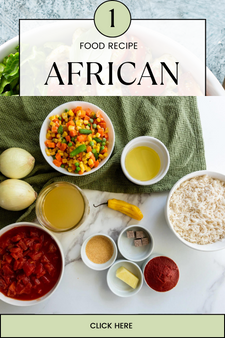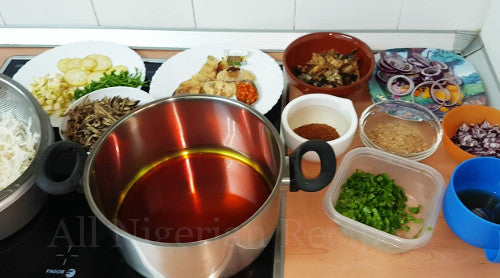Abacha the meal, is one of those meals that are prepared with lots of ingredients. Here is a full option Abacha that contains all the possible ingredients.
If you do not have Abacha or you are on a low carb diet, preper cucumber abacha.
Abacha(the ingredient) is made from cassava. The cassava tubers are cooked till done then sliced with a special grater. The sliced cassava is then soaked in cold water overnight, washed thoroughly and dried under the sun.
Ingredients for Abacha
With Abacha, the more ingredients you use, the tastier and more "complete" it will be. So use as many as you can lay your hands on.
- 3 handfuls abacha
- 2 cups ugba (ukpaka)
- 30 cl red palm oil
- 2 tablespoons powereded potash (food tenderizer)
- Fish | Mackerel/Dry Fish/Stockfish
- 2 onions
- Salt and habanero pepper (to taste)
- 4 tablespoons ground cryfish
- 2 stock cubes (Knorr)
- 2 teaspoons ground Ehu seeds (Calabash Nutmeg)
- Garden Eggs.
- Garden Egg leaves
- Ogiri Igbo (castor seed paste)
Other meat and vegetables for the Abacha
- 3 Fresh Utazi leaves (Gongronema latifolium)
- Ponmo / Kanda (cow skin)
Notes on the ingredients:
- Abacha is the main ingredient. Abacha is made by boiling and grating/shredding cassava tubers.
- Ukpaka or Ugba is shredded oil bean seeds. It is compulsory for me but if you do not have it, you can skip it.
- Red Palm Oil must be used when preparing abacha. Other oils are not acceptable.
- You must add a green leafy vegetable. Garden Egg leaves are used for abacha. If you do not have it, use leafy spinach especially the baby ones. Very good alternative.
- At least one type of fish must be used. For abacha you can use stockfish (dry cod), dry fish (dry cat fish, mangala), fried mackerel (fried titus) and smoked fish
- Crayfish much be used,
- Pepper must be used and you can either add habanero pepper (recommended) or dry cayenne pepper. Habanero pepper is atarodo, atarugu or ose oyibo. Black pepper is not a good fit for abacha.
- Add ogiri Igbo for the classic traditional taste but if you do not have it, add stock cubes. One of these must be used unless you are really really allergic to both.
- Add garden egg. It is great in abacha but not compulsory.
- For me, red onions are a must. My grandma will tell me that adding onions is "umu township" version. LOL
- Edible potash: akanwu, kaun, keun is what makes palm oil curdle and it is a must. If you do not have it or you do not want to eat edible potash, baking soda (bicarbonate of soda) has similar properties.
- Ehu: for me ehu (calabash nutmeg or African nutmeg) is a must. Again if you do not have it, you can skip it. But the day you will eat Abacha prepared with ehu, you will understand the difference between capital B and cow footprint. LOL
- Be careful when adding salt to abacha. This meal contains lots of ingredients that already have salt: stockfish, stock cubes, crayfish etc. Most often I do not need more salt.
Before you Make Abacha
All the work of making Abacha goes to preparing the ingredients.
- Soak the dry fish in cool water and set aside to soften.
- Soak the abacha for 2 minutes in cool water and put in a sieve to drain.
- Rinse the stockfish and cook till soft. I use a pressure pot for this. Debone when it is soft.
- Mix the edible potash with some water, stir and set aside.
- When the dry fish is soft, clean and debone. Then break into small pieces.
- Cut one of the onions into tiny pieces and cut the other into rings. See the video for what I mean.
- Rinse the leafy vegetable, cut some into tiny pieces, some into thin stripes and leave some leaves whole.
- Rinse the ukpaka and put in a sieve to drain.
- Cut some garden egg into tiny pieces and some into thin discs.
- Crack open the ehu seeds and grind with a spice grinder.
- Grind/blend/pound the habanero pepper.
- Melt the palm oil in a sizeable pot over low heat. Note that this is melting not bleaching. The oil should not even be hot. If your palm oil is in liquid form, no need to use heat. Just pour it into a pot.
All the ingredients are ready!








